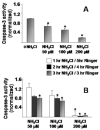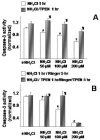Monochloramine impairs caspase-3 through thiol oxidation and Zn2+ release
- PMID: 19118843
- PMCID: PMC2699399
- DOI: 10.1016/j.jss.2008.05.021
Monochloramine impairs caspase-3 through thiol oxidation and Zn2+ release
Abstract
Background: Caspase-3, a pro-apoptotic enzyme, represents a class of proteins in which the active site contains reduced thiol (S-H) groups and is modulated by heavy metal cations, such as Zn(2+). We explored the effects of the thiol oxidant monochloramine (NH(2)Cl) on caspase-3 activity within cells of isolated rabbit gastric glands. In addition, we tested the hypothesis that NH(2)Cl-induced alterations of caspase-3 activity are modulated by oxidant-induced accumulation of Zn(2+) within the cytoplasm.
Materials and methods: Isolated gastric glands were prepared from rabbit mucosa by collagenase digestion. Caspase-3 activity was measured colorimetrically in suspensions of healthy rabbit gastric glands, following exposure to various concentrations of NH(2)Cl with or without the zinc chelator TPEN [tetrakis-(2-pyridylmethyl)ethylene diamine] for 1 h, and re-equilibration in Ringer's solution for 5 h. Conversion of procaspase-3 to active caspase-3 was monitored by Western blot.
Results: Monochloramine inhibited caspase-3 activity in a dose-dependent fashion. At concentrations of NH(2)Cl up to 100 microM, these effects were prevented if TPEN was given concurrently and were partly reversed if TPEN was given 1 h later. Caspase-3 activity was preserved by concurrent treatment with a thiol-reducing agent, dithiothreitol.
Conclusions: At pathologically relevant concentrations, NH(2)Cl impairs caspase-3 activity through oxidation of its thiol groups. Independently from its thiol oxidant effects on the enzyme, NH(2)Cl-induced accumulation of Zn(2+) in the cytoplasm is sufficient to restrain endogenous caspase-3 activity. Our studies suggest that some bacterially generated oxidants, such as NH(2)Cl, impair host pathways of apoptosis through release of Zn(2+) from endogenous pools.
Figures





Similar articles
-
Thiol-oxidant monochloramine mobilizes intracellular Ca2+ in parietal cells of rabbit gastric glands.Am J Physiol Cell Physiol. 2007 Nov;293(5):C1687-97. doi: 10.1152/ajpcell.00189.2006. Epub 2007 Feb 7. Am J Physiol Cell Physiol. 2007. PMID: 17287368
-
Monochloramine-induced toxicity and dysregulation of intracellular Zn2+ in parietal cells of rabbit gastric glands.Am J Physiol Gastrointest Liver Physiol. 2010 Jul;299(1):G170-8. doi: 10.1152/ajpgi.00355.2009. Epub 2010 Apr 29. Am J Physiol Gastrointest Liver Physiol. 2010. PMID: 20430873 Free PMC article.
-
Intracellular Ca(2+) and Zn(2+) signals during monochloramine-induced oxidative stress in isolated rat colon crypts.Am J Physiol Gastrointest Liver Physiol. 2006 Feb;290(2):G250-61. doi: 10.1152/ajpgi.00501.2004. Epub 2005 Jul 7. Am J Physiol Gastrointest Liver Physiol. 2006. PMID: 16002562
-
Monochloramine inhibits etoposide-induced apoptosis with an increase in DNA aberration.Free Radic Biol Med. 2001 Apr 15;30(8):932-40. doi: 10.1016/s0891-5849(01)00496-8. Free Radic Biol Med. 2001. PMID: 11295536
-
[Role of ammonia-monochloramine system in Helicobacter pylori--induced gastric mucosal injury].Nihon Rinsho. 1993 Dec;51(12):3154-8. Nihon Rinsho. 1993. PMID: 8283624 Review. Japanese.
Cited by
-
Neurochemical characterization of zinc transporter 3-like immunoreactive (ZnT3(+)) neurons in the intramural ganglia of the porcine duodenum.J Mol Neurosci. 2012 Nov;48(3):766-76. doi: 10.1007/s12031-012-9855-9. Epub 2012 Jul 12. J Mol Neurosci. 2012. PMID: 22791190 Free PMC article.
-
Demand for Zn2+ in acid-secreting gastric mucosa and its requirement for intracellular Ca2+.PLoS One. 2011;6(6):e19638. doi: 10.1371/journal.pone.0019638. Epub 2011 Jun 15. PLoS One. 2011. PMID: 21698273 Free PMC article.
-
Zinc bells rang in Jerusalem!Sci Signal. 2010 Jul 6;3(129):mr2. doi: 10.1126/scisignal.3129mr2. Sci Signal. 2010. PMID: 20606213 Free PMC article.
-
A multipronged approach for compiling a global map of allosteric regulation in the apoptotic caspases.Methods Enzymol. 2014;544:215-49. doi: 10.1016/B978-0-12-417158-9.00009-1. Methods Enzymol. 2014. PMID: 24974292 Free PMC article.
-
Mechanism of zinc-mediated inhibition of caspase-9.Protein Sci. 2012 Jul;21(7):1056-65. doi: 10.1002/pro.2090. Epub 2012 May 24. Protein Sci. 2012. PMID: 22573662 Free PMC article.
References
-
- Suerbaum S, Michetti P. Helicobacter pylori Infection. New England Journal of Medicine. 2002;347:1175–1186. - PubMed
-
- Yoshikawa T, Naito Y. The role of neutrophils and inflammation in gastric mucosal injury. Free Radical Research. 2000;33:785–794. - PubMed
-
- Dekigai H, Murakami M, Kita T. Mechanism of Helicobacter pylori-associated gastric mucosal injury. Digestive Diseases and Sciences. 1995;40:1332–1339. - PubMed
-
- Suzuki M, Miura S, Suematsu M, Fukumura D, Kurose I, Suzuki H, Kai A, Kudoh Y, Ohashi M, Tsuchiya M. Helicobacter pylori-associated ammonia production enhances neutrophil dependent gastric mucosal injury. American Journal of Physiology. 1992;263:G719–G725. - PubMed
-
- Grisham MB, Gaginella TS, von Ritter C, Tamai H, Be RM, Granger DN. Effects of neutrophil-derived oxidants on intestinal permeability, electrolyte transport, epithelial cell viability. Inflammation. 1990;14:531–542. - PubMed
Publication types
MeSH terms
Substances
Grants and funding
LinkOut - more resources
Full Text Sources
Research Materials

